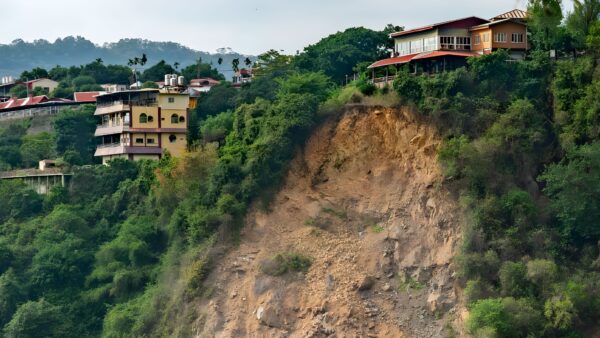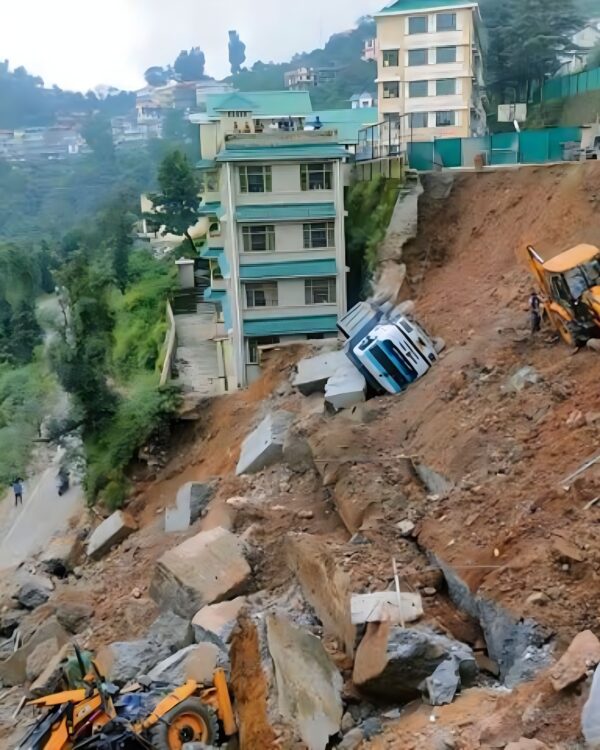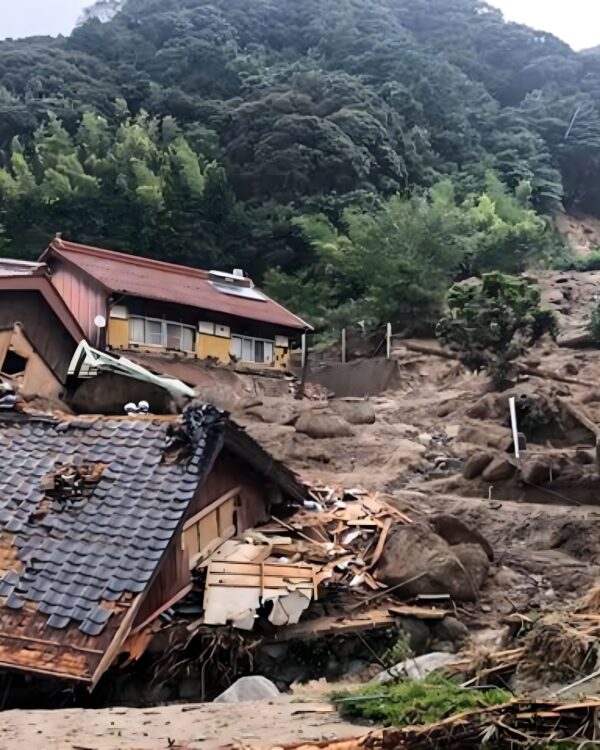Analyzing Landslide Threats in Himachal Pradesh : The state of Himachal Pradesh, nestled in the Himalayas, faces a growing challenge – landslides. The state’s geological composition, characterized by steep slopes and fragile rock formations, coupled with increasing precipitation intensity, has led to a significant rise in landslide occurrences. Several factors contribute to landslide vulnerability in the region. Natural triggers include inherent slope instability due to steep topography and the presence of fragile geological formations. However, human activities such as uncontrolled deforestation, unplanned infrastructure development with inadequate drainage systems, and unsustainable construction practices further exacerbate the situation.
The consequences of these landslides are far-reaching. Loss of life, damage to buildings and transportation networks, and disruption of essential services like electricity and water supply are just some of the immediate impacts. The long-term economic and social costs can be equally devastating. This necessitates a proactive approach to mitigate these threats and ensure the safety of residents and infrastructure.
Understanding Landslide Threats in Himachal Pradesh
A comprehensive understanding of the causative factors is essential for developing effective solutions. Landslides in Himachal Pradesh are triggered by a complex interplay of natural and anthropogenic factors.
Natural Hazards
The inherent instability of the region, characterized by steep slopes and geologically weak formations, is exacerbated by intense rainfall events, a phenomenon expected to become more frequent due to climate change.
Read Also : Exploring Himachali Hospitality: A Guide to 10 best Homestays in Shimla
Steep Slopes
The latent instability of steep slopes is a primary cause. As the angle of inclination increases, so does the susceptibility to landslides.
Weak Rock Formations
Certain rock types, such as weathered shales and phyllites, are more prone to erosion and failure under stress.
Intense Rainfall
Heavy precipitation saturates the soil, increasing pore water pressure and reducing the internal friction that holds slopes together.
Anthropogenic Activities : Human activities further exacerbate these natural vulnerabilities :
Uncontrolled Deforestation
Removal of vegetation weakens the root network that binds soil particles, leading to increased soil erosion and slope instability.
Unsustainable Construction Practices
Road widening projects with inadequate drainage systems and poorly designed slopes can disrupt natural drainage patterns and trigger landslides.
Read Also : A Culinary Adventure: Explore Shimla 10 Best Restaurants And Cafe
Increasing Infrastructure Development
The growing demand for infrastructure in fragile mountain ecosystems can lead to deforestation and slope destabilization.
Geohazard Mitigation Strategies : Potential Solutions
Combating landslide threats requires a comprehensive approach that integrates geoscientific knowledge with responsible development practices. A multi-faceted approach is required for sustainable landslide risk reduction. Here are some potential solutions:
Comprehensive Hazard Mapping and Risk Assessment
Detailed and comprehensive landslide hazard mapping, incorporating geospatial technology, is crucial for informed land-use planning. Identifying high-risk zones allows authorities to steer development away from these areas, safeguarding lives and infrastructure and also preventing future threats.
Slope Stabilization Techniques
Engineering solutions such as reinforced slopes, retaining walls, and properly designed drainage systems can significantly improve slope stability, particularly along critical infrastructure corridors.
Promoting Afforestation Programs
Promoting large-scale plantation drives with native, deep-rooted vegetation strengthens the integrity of slopes by binding soil particles together. This natural solution not only reduces erosion but also enhances overall ecological health.
Regulation and Enforcement
Strengthening regulations on construction activities in vulnerable areas and ensuring strict enforcement is paramount. This can involve conducting environmental impact assessments for projects and implementing penalties for non-compliance to ensure responsible development practices.
Promoting Sustainable Infrastructure Development
Engineering advancements play a vital role. Techniques such as reinforced slopes, strategically placed retaining walls, and well-designed drainage systems integrated into road construction projects can significantly enhance slope stability.
Early Warning Systems
Developing and deploying advanced early warning systems that monitor rainfall patterns, slope movement and seismic activity provides valuable lead time for evacuations in case of impending landslides. These systems can significantly reduce casualties and property damages.
By combining these scientific solutions, stricter regulations, and a focus on sustainable development practices, the state can effectively mitigate landslide risks.
Lessons from Japan: A Seismic Sibling in Landslide Management
Himachal Pradesh can glean valuable insights from Japan’s extensive experience in mitigating landslide hazards. Here are some key areas where Japan’s expertise can be particularly beneficial:
Advanced Monitoring and Early Warning Systems
Japan has invested heavily in sophisticated monitoring networks. These systems utilize rain gauges, tiltmeters, and seismic sensors to detect changes in slope stability and predict potential landslides with greater accuracy.
Bioengineering Techniques for Slope Stabilization
Japan has pioneered bioengineering techniques that combine engineering solutions with natural elements. Techniques like vegetation cover reinforcement with wire mesh and the use of deep-rooted plants specifically chosen for slope stabilization can be highly effective and environmentally friendly.
Community Preparedness and Evacuation Planning
Japan emphasizes public awareness and preparedness drills. Himachal Pradesh can leverage this knowledge to develop robust community-based disaster risk reduction programs. Educating residents on landslide warning signs, evacuation routes, and emergency protocols can significantly improve community resilience.
Knowledge Sharing and Technology
Transfer Collaboration between Japanese and Indian geoscientists and engineers can facilitate knowledge exchange and technology transfer. Joint research projects and training programs can equip Himachal Pradesh with the expertise to develop and implement cutting-edge landslide mitigation strategies tailored to its unique geological context.
Learning from Historical Events
Both Japan and Himachal Pradesh are prone to frequent earthquakes. Studying how Japan has analyzed past earthquake-triggered landslides and incorporated those learnings into their mitigation strategies can provide valuable insights for Himachal Pradesh.
Conclusion: A Collaborative Approach for a Sustainable Future
Mitigating landslide risks in Himachal Pradesh requires a collaborative effort from geoscientists, engineers, policymakers, and local communities. By integrating scientific knowledge with responsible development practices and stricter regulations, the state can safeguard its people and infrastructure from this ever-present threat. Raising public awareness and promoting community participation in monitoring and reporting can further strengthen the state’s landslide mitigation strategy.
Through proactive planning, responsible development, and a commitment to environmental sustainability, Himachal Pradesh can ensure the safety of its people and infrastructure, allowing future generations to continue cherishing the splendor of the Himalayas.
Frequently Asked Questions
Q. What are the dangers of landslides?
Answer – Landslides can cause significant damage and loss of life. They can block roads, destroy infrastructure, and bury entire settlements.
Q. Are there any areas of Himachal Pradesh more at risk?
Answer – The hilly regions, especially those with fragile geology and a history of landslides, are at higher risk.
Q. How can landslides be prevented?
Answer – Complete prevention might not be possible, but some measures can help mitigate risks:
Proper land-use planning: Avoiding construction in high-risk areas and implementing stricter building codes in vulnerable zones.
Slope stabilization techniques: Using engineering solutions like retaining walls to reinforce slopes.
Reforestation programs: Planting trees to restore lost vegetation cover and improve slope stability.
Q. What is the government doing about landslide hazards?
Answer – The government is taking steps like:
Installing early warning systems: These systems monitor slopes for signs of movement and can warn residents of potential landslides.
Developing landslide risk maps: Identifying high-risk areas can help guide development and disaster preparedness efforts.
Q. What can I do to stay safe from landslides?
Be aware of your surroundings: Learn about landslide risks in your area and identify potential triggers like heavy rain.
Stay informed: Monitor weather forecasts and warnings issued by disaster management authorities.
Have a plan: Develop a plan for evacuation in case of a landslide and practice it regularly with your family.
Q. Who can I contact if I see signs of a landslide?
Answer – Report any signs of a potential landslide, like cracks in walls or unusual ground movement, to the local authorities immediately.
Q. Are there any resources available for learning more about landslides?
Answer – Yes, the Geological Survey of India (GSI) and the Himachal Pradesh State Disaster Management Authority (HPSDMA) have resources and information on landslides.
Q. How do landslides affect the environment in Himachal Pradesh?
Answer – Landslides can cause soil erosion, sedimentation in rivers, and damage to natural habitats.
Q. Are there any economic consequences of landslides?
Answer – Landslides can disrupt transportation networks, damage infrastructure, and hinder economic activity like tourism and agriculture.
Q. What role does climate change play in increasing landslide risks?
Answer – Climate change is expected to lead to more extreme weather events, including heavy rainfall, which can increase the risk of landslides.
Q. How can local communities be involved in landslide risk reduction?
Answer – Local communities have valuable knowledge about their environment. They can be involved in monitoring slopes, reporting risks, and participating in disaster preparedness efforts.
Q. What are some traditional techniques used to prevent landslides in Himachal Pradesh?
Answer – Traditional techniques include building terraces to minimize slope angles and using local materials like stone walls for reinforcement.
Q. What are the challenges in addressing landslide hazards in Himachal Pradesh?
Answer – Balancing development needs with environmental protection, enforcing regulations effectively, and raising public awareness about landslide risks are some key challenges.
Q. Are landslides becoming more common in Himachal Pradesh?
Answer – Yes, unfortunately, landslides are becoming increasingly frequent and severe in Himachal Pradesh.
Q. What are the main reasons for this increase?
Answer – There are several factors contributing to this, including:
Increased intensity of rainfall: While the total rainfall duration might be decreasing, the intensity of downpours is rising, making slopes more vulnerable.
Unregulated construction activities: Road widening, dam construction, and unregulated building on slopes all destabilize the fragile mountain ecosystem.
Deforestation: Trees play a vital role in binding soil together. Increased deforestation weakens slopes and makes them more prone to landslides.

Dikshit Sharma is an inquisitive writer with a passion for uncovering the stories behind everyday life. His work features themes like food, culture, travel and much more. Whether it’s delving into local culture or exploring hidden trends, he loves to weave captivating narratives that bring everyday experiences to life with vivid storytelling.




















